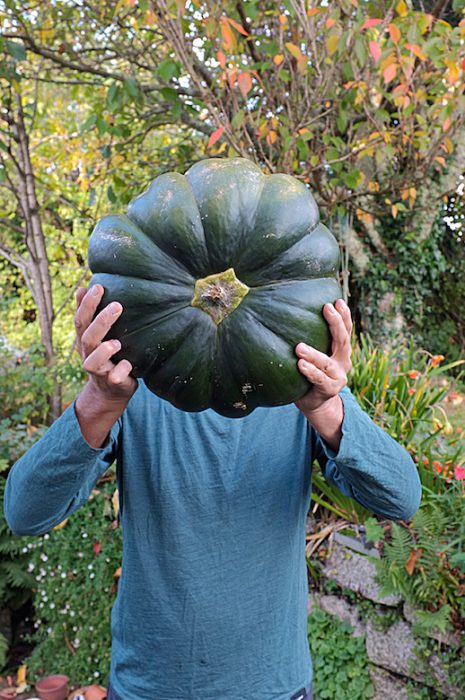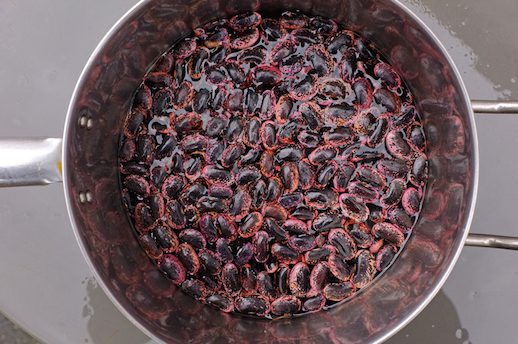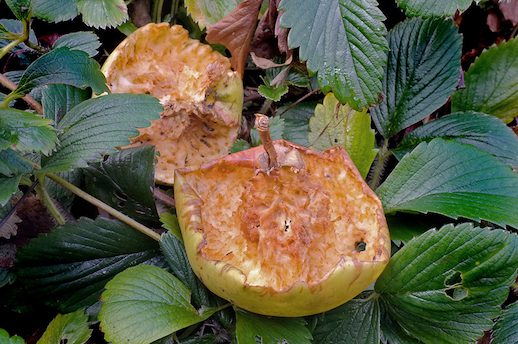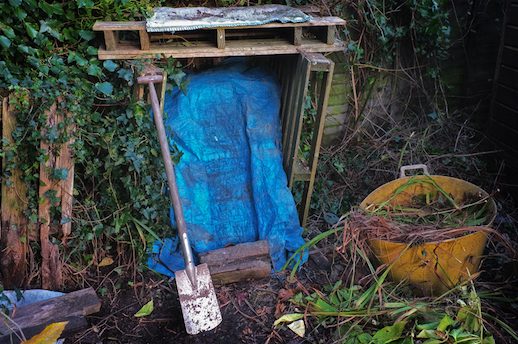A long-awaited update from Cornwall – featuring bunnies, borlotti beans, and blight
Words & pictures: Stephen ‘Spoonful’ Parker
Slipping on autumn leaves, I stagger up the garden clutching a rotten plastic sack full of soaking wet horse manure. At the compost heap I bend with relief to drop the bag. The force of a 50-pound sack of saturated horse manure hitting the ground – I know now – will expel at least a half a pint of cold brown shit-water into your face. I’m pebble-dashed in excrement. Spitting, coughing and laughing, I wipe my face – in some far-flung part of the world there is probably a spa that will offer the same treatment for a small fortune.
This is my ‘review’ of the year in my Penryn garden on a hill within sight of the Atlantic ocean in Cornwall. As usual it’s been topsy-turvy, with unexpected triumphs and unpredictable tragedies, the year only stuttering into life in early April.
I have learnt that pressing a palm on to the soil’s surface or thrusting a hand deep into the earth in the spring will tell me whether the soil is warm enough to start planting. But even in April it’s still too cold. This will turn out to affect the whole year, with summer plants growing well into October.
The effort and energy required to kick-start the garden into life doesn’t seem available to me this year. It’s been another long and ghastly winter and, as usual, my spirits have sunk in the late winter rain. However, heeding my father-in-law’s advice, I concentrate on one small area at a time, clearing the winter weeds, raking over the soil. Looking back at a small completed patch is much more satisfying than staring out the window at an unruly garden where the work is barely noticeable.
As spring progresses, I sow beans in the greenhouse alongside the cabbage tribe and my ever-faithful pumpkins and squash. The weather stays cool, things are slow and I’m still not that interested in the garden. But dutifully I plod on, knowing the results won’t be sampled for a few months and by then I’ll feel better and will regret turning my back on the vital early work.
By May the French, runner and borlotti beans have climbed 6-inches high in the greenhouse and look splendid so it’s time to plant them out. They dislike the move from the warmth and hang around all pale and sulky, refusing to grow.
One morning, looking across the garden, something seems odd. The borlotti leaves are limp, the foot-high plants drooping in the morning sun. Every plant has been sliced through at a height of 4 inches and a 30-degree angle. Twenty plants razored in the night. Then I remember the shouts of glee from my daughters the previous week. Rabbits in the garden! Even teenagers like rabbits; cute little fluffy-tailed borlotti bean assassins.
I harbour murderous thoughts as I stare dejectedly at the damage, then trudge off to plant another set of beans. The only way to remedy such disappointment is to try and redress the situation immediately – but it’s a blow after all that work; six weeks wasted.
Over the next couple of months despite my efforts to cover as many plants as possible, the rabbits attack again and again. Everywhere you look there’s netting and planks of wood in an attempt to keep them at bay. Eventually there is enough food for the bunnies elsewhere, but their occasional appearances in the garden see me hurling stones, once an old parsnip and on one futile day a cardboard box at their disappearing tails.
By late May the sun has arrived and it’s lovely to be out working in the cooling Cornish evening air. One night after dinner – pumpkin soup from last year’s frozen crop – I’m happily cutting my own bamboo canes for the beans when 13-year old Berry appears by the back door looking aghast.
‘Mum’s just been sick in the street!’ she says, shaking her head in disbelief. A couple of minutes later an ashen-faced wife appears. Picking up Berry from jazz-band rehearsal, she had to veer across a road, jump out of the car and throw up. ‘It was everywhere,’ reports Berry. ‘Disgusting.’
It seems that now, oh ironies of ironies, my sweetheart is allergic to my valentine of the garden, the pumpkin. She confirms this a few days later (rather too proudly in my opinion), announcing ‘It’s a very rare allergy, actually.’ Of course, this year now turns out to be a triumph in the Penryn garden for pumpkins and squashes, with huge monsters flexing their muscly bodies like a vegetable Mr Universe competition. Certainly the biggest and most handsome I have ever grown. In the late evening light they seem to emit a dark glow from beneath their canopy of leaves.
By the early part of the summer, after a lot of hard digging, the potatoes, both earlys and mids, are growing well. Then the weather changes again and rain is back with a vengeance. Wet and mild is ‘blighty weather’, when blight attacks. All it takes is a 12-hour period of 10 degrees or higher with 90 per cent humidity. Farmers get issued a warning; those not in the know, like me, wake up to find the tell-tale signs of a watery rot setting in. The progress is fast this year; I have to chop down the plants that day, leaving a bed full of miniature, marble-sized potatoes. A nightmare to get rid of, they will regrow by the hundred, upsetting whatever is planted there next. To dig them out would take hours so we’ll either have an extraordinary harvest next year or a total mess.
As autumn sets into winter it appears, on the whole, to have been a good year. Cabbages and leeks stand tall, the tomatoes thrive in the greenhouse, and the beans – finally – grow, and grow well. In fact the runner beans do so well that I pick the last, huge ones in late October. By now the pods are tough as old boots but the beans inside, boiled and cooked with sausages, are a treat.
Probably the most bountiful harvest this year are the dusky, purple plums, and one of the apple trees droops with its huge, lemony fruit almost touching the ground. We dilly-dally collecting the plums and the birds have a feast. The apples hang in such quantity that I happily watch my blackbird (who’s not allowed near the gooseberries) scoff away, getting really stuck in then leaving the apple shells hollowed out.
So the last job of the year is to stack up the compost heap. Two weeks of weeding, a year’s worth of kitchen scraps, a sack of fire ash, some shredded cardboard boxes and as much seaweed and nettles as possible are thrown onto the heap. One final massive effort to turn the heavy, half-rotted summer heap over onto the new one results in a huge, wonderful and very smelly fresh pile. It’s 4pm on a Sunday, and as the grey sky darkens and the wind slips in off the sea I think of wine and dinner. I tuck the heap in for the winter with a cosy plastic blanket, murmuring to myself with satisfaction – it’s one of my favourite jobs. By the time spring arrives it will have rotted down and be ready to dig into the garden when the whole cycle starts again.



